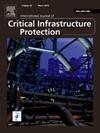Securing the future: Integrating quantum computing and digital twin technologies into modern power & transportation systems for resilient smart cities against false data injection cyberattacks
IF 5.3
3区 工程技术
Q1 COMPUTER SCIENCE, INFORMATION SYSTEMS
International Journal of Critical Infrastructure Protection
Pub Date : 2025-10-12
DOI:10.1016/j.ijcip.2025.100807
引用次数: 0
Abstract
The rapid evolution of smart cities relies on the integration of advanced technologies to enhance urban infrastructure, ensure system resilience, and address growing cybersecurity challenges. Toward that end, this paper scrutinizes the convergence of quantum computing (QC) and digital twin (DT) technologies as a novel solution to mitigate false data injection (FDI) cyberattacks, an escalating threat to the integrity of data-driven power and transportation systems. By combining the computational advantages of quantum algorithms with the real-time monitoring and simulation capabilities of DTs, this paper proposes an integrated framework along with a novel optimization algorithm for early detection, prevention, and mitigation of FDI attacks. The effectiveness of the proposed approach is demonstrated through a modified IEEE 39-bus power system coupled with an urban transportation network, highlighting improved system security, operational efficiency, and sustainability. This work contributes a forward-looking pathway for securing interconnected smart city infrastructures against evolving cyber threats.
保护未来:将量子计算和数字孪生技术集成到现代电力和交通系统中,以实现弹性智能城市抵御虚假数据注入网络攻击
智慧城市的快速发展依赖于先进技术的整合,以增强城市基础设施,确保系统弹性,并应对日益增长的网络安全挑战。为此,本文仔细研究了量子计算(QC)和数字孪生(DT)技术的融合,作为减轻虚假数据注入(FDI)网络攻击的新解决方案,虚假数据注入(FDI)网络攻击是对数据驱动的电力和运输系统完整性的不断升级的威胁。通过将量子算法的计算优势与dt的实时监控和模拟能力相结合,本文提出了一个集成框架以及一种新的优化算法,用于早期检测、预防和减轻FDI攻击。通过改进的IEEE 39总线电力系统与城市交通网络相结合,证明了所提出方法的有效性,突出了系统安全性、运行效率和可持续性的提高。这项工作为保护互联的智慧城市基础设施免受不断变化的网络威胁提供了前瞻性途径。
本文章由计算机程序翻译,如有差异,请以英文原文为准。
求助全文
约1分钟内获得全文
求助全文
来源期刊

International Journal of Critical Infrastructure Protection
COMPUTER SCIENCE, INFORMATION SYSTEMS-ENGINEERING, MULTIDISCIPLINARY
CiteScore
8.90
自引率
5.60%
发文量
46
审稿时长
>12 weeks
期刊介绍:
The International Journal of Critical Infrastructure Protection (IJCIP) was launched in 2008, with the primary aim of publishing scholarly papers of the highest quality in all areas of critical infrastructure protection. Of particular interest are articles that weave science, technology, law and policy to craft sophisticated yet practical solutions for securing assets in the various critical infrastructure sectors. These critical infrastructure sectors include: information technology, telecommunications, energy, banking and finance, transportation systems, chemicals, critical manufacturing, agriculture and food, defense industrial base, public health and health care, national monuments and icons, drinking water and water treatment systems, commercial facilities, dams, emergency services, nuclear reactors, materials and waste, postal and shipping, and government facilities. Protecting and ensuring the continuity of operation of critical infrastructure assets are vital to national security, public health and safety, economic vitality, and societal wellbeing.
The scope of the journal includes, but is not limited to:
1. Analysis of security challenges that are unique or common to the various infrastructure sectors.
2. Identification of core security principles and techniques that can be applied to critical infrastructure protection.
3. Elucidation of the dependencies and interdependencies existing between infrastructure sectors and techniques for mitigating the devastating effects of cascading failures.
4. Creation of sophisticated, yet practical, solutions, for critical infrastructure protection that involve mathematical, scientific and engineering techniques, economic and social science methods, and/or legal and public policy constructs.
 求助内容:
求助内容: 应助结果提醒方式:
应助结果提醒方式:


